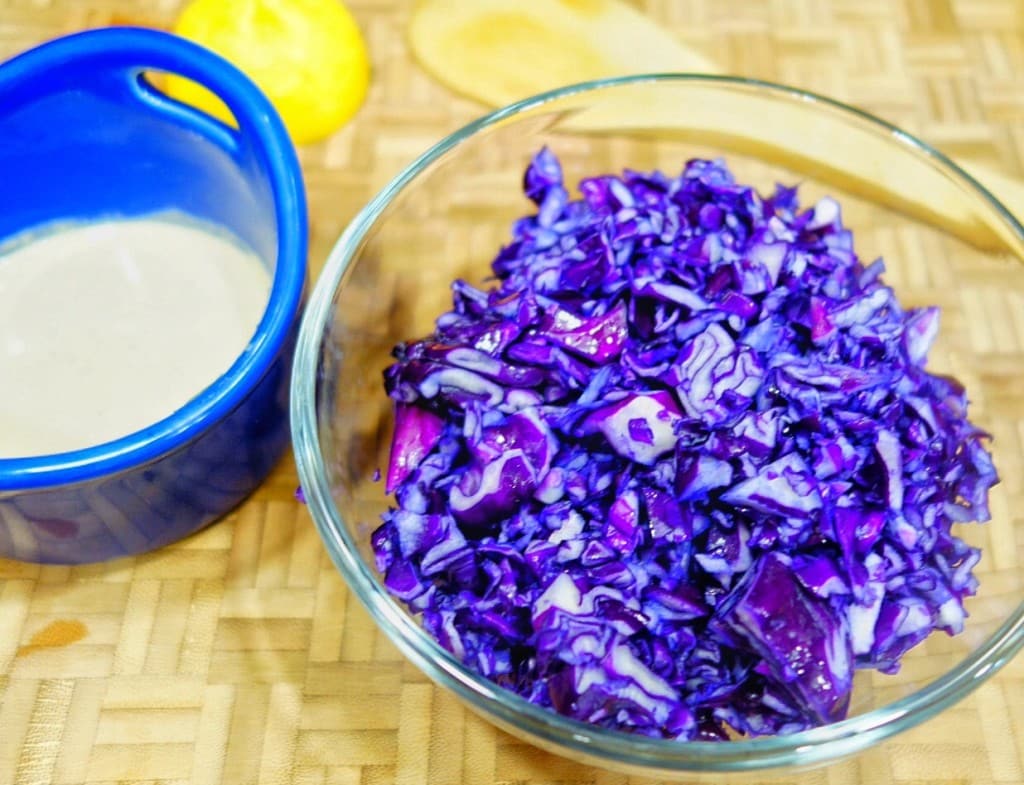A part of the cruciferous family – leafy powerhouse cabbage is one of the oldest known vegetables, which dates back to the Greek and Roman times. The Romans even used it to cure hangovers! This is my favorite way to use it.
Studies show that different types of cabbage contain different amounts of nutrients, so the more you include them in your diet, the more health benefits you gain! Among the different types – green cabbage, Nappa cabbage, red cabbage, savoy cabbage, bok choy and Brussels sprouts – red cabbage is one of my favorites.
Did you know that the intense purple color in red cabbage is an indication of its strong levels of nutrients? Well, now you do!
Red cabbage, also known as purple cabbage or red kraut, is undoubtedly a wealth of vitamins. It’s packed with antioxidants, nutrients, minerals and vitamins like calcium, dietary fiber, folate, iron, magnesium, manganese, potassium, riboflavin, thiamin, and vitamins A, B, C, E and K.
With its high levels of antioxidants, red cabbage is effective for boosting your immune system and fighting off cancer. It eliminates free radicals that are responsible for chronic diseases like breast and lung cancer, diabetes and heart disease. Red cabbage is particularly rich in vitamin C. It even contains almost twice the content in green cabbage!
If you’re trying to maintain a healthy weight or trying to improve your calorie intake, red cabbage is highly recommended. It’s the best for a wide variety of dishes as it is high in dietary fiber, but very low in calories, so it makes you feel full and away from pointless cravings. One cooked cup only contains 44 calories! Its dietary fiber also prevents constipation, treats stomach problems, and maintains a healthy digestive track.
Red cabbage is also good for your skin. The high levels of vitamin A keeps your skin fresh, protects you from sun damage, promotes re-growth of skin cells, and reduces wrinkles, dark spots, and other signs of aging. Additionally, vitamin A boosts eye health, so you’re safe from macular degeneration and cataracts.
Alzheimer’s disease is one of the most tragic diseases in the world, and fortunately red cabbage can reduce your risk of it, all thanks to its vitamin K! It helps improve mental function and concentration, as well as prevents nerve damage.
As I’ve mentioned above, red cabbage is packed with calcium, magnesium and manganese, and these three promote bone growth and development, even protect against osteoporosis and arthritis.
Red cabbage is cheap and is available all year round, so you can have it all you want! When buying cabbages in general, it’s important to make sure that they are crisp and damage-free, as severe damages can indicate decay. Avoid buying those pre-cut ones because it has a decreased level of vitamin C. Fresh cabbages can be stored in the fridge for up to two weeks.
Though you can eat it raw, boiled, sautéed, or stuffed, the best way to cook red cabbage is through steaming. It has some sort of special powers in lowering your cholesterol levels! It’s even better than cooking it in the microwave, as microwaving can destroy several anti-cancer compounds. It’s so easy to cook and can be used in a wide variety of dishes. Personally, I love adding it to my salads, smoothies, tacos and more!
To get the most health benefits, consume cabbage and other cruciferous vegetables like cauliflower, kale and broccoli four to five times a week.
Other benefits of red cabbage include:
1. Regulates blood pressure and blood sugar
2. Protects pregnant women from anemia
3. Treats ulcer pains
4. Treats headaches





